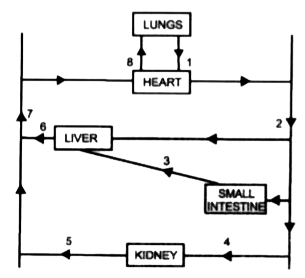What is the circulatory system?
Step-by-Step Solution:
1. Definition of the Circulatory System: The circulatory system is a vital system in the human body responsible for the transport of blood, nutrients, hormones, and waste products from one part of the body to another.
2. Components of the Circulatory System:
- Fluid Connective Tissue: The primary fluid connective tissue in the circulatory system is blood. Blood plays a crucial role in transporting various substances throughout the body.
- Pumping Organ: The heart is the main pumping organ of the circulatory system. Its primary function is to pump blood throughout the body, ensuring that all tissues receive the necessary nutrients and oxygen.
- Blood Vessels: The circulatory system includes a network of blood vessels, which are classified into three main types: arteries, veins, and capillaries. These vessels are responsible for transporting blood to and from the heart and throughout the body.
3. Functions of Blood: Blood has several important functions, including:
- Transporting oxygen and nutrients to tissues.
- Carrying hormones and drugs to various parts of the body.
- Removing waste products such as carbon dioxide, urea, and uric acid from tissues.
4. Types of Blood Vessels:
- Arteries: These vessels carry oxygenated blood away from the heart to the tissues. They are generally thicker and more muscular to handle the high pressure of blood being pumped from the heart.
- Veins: Veins carry deoxygenated blood back to the heart from the tissues. They have thinner walls and often contain valves to prevent backflow of blood.
- Capillaries: These are tiny blood vessels that connect arteries and veins. They facilitate the exchange of oxygen, nutrients, and waste products between blood and tissues.
5. Differentiation of Blood: The heart also plays a role in differentiating between oxygenated and deoxygenated blood, ensuring that oxygen-rich blood is delivered to the body while deoxygenated blood is returned to the heart for re-oxygenation.
Final Summary: The circulatory system consists of blood (the fluid connective tissue), the heart (the pumping organ), and blood vessels (arteries, veins, and capillaries). It is essential for transporting vital substances throughout the body and removing waste products.
---
- Fluid Connective Tissue: The primary fluid connective tissue in the circulatory system is blood. Blood plays a crucial role in transporting various substances throughout the body.
- Pumping Organ: The heart is the main pumping organ of the circulatory system. Its primary function is to pump blood throughout the body, ensuring that all tissues receive the necessary nutrients and oxygen.
- Blood Vessels: The circulatory system includes a network of blood vessels, which are classified into three main types: arteries, veins, and capillaries. These vessels are responsible for transporting blood to and from the heart and throughout the body.
- Transporting oxygen and nutrients to tissues.
- Carrying hormones and drugs to various parts of the body.
- Removing waste products such as carbon dioxide, urea, and uric acid from tissues.
- Arteries: These vessels carry oxygenated blood away from the heart to the tissues. They are generally thicker and more muscular to handle the high pressure of blood being pumped from the heart.
- Veins: Veins carry deoxygenated blood back to the heart from the tissues. They have thinner walls and often contain valves to prevent backflow of blood.
- Capillaries: These are tiny blood vessels that connect arteries and veins. They facilitate the exchange of oxygen, nutrients, and waste products between blood and tissues.
Topper's Solved these Questions
- CIRCULATORY SYSTEM IN HUMANS BOOK - ICSECHAPTER - CIRCULATORY SYSTEM IN HUMANS EXERCISE - Exercises(Answer the following in detail.)
5 Videos
- CIRCULATORY SYSTEM IN HUMANS BOOK - ICSECHAPTER - CIRCULATORY SYSTEM IN HUMANS EXERCISE - Exercises
4 Videos
- CIRCULATORY SYSTEM IN HUMANS BOOK - ICSECHAPTER - CIRCULATORY SYSTEM IN HUMANS EXERCISE - Exercises (Define the following terms.)
4 Videos
- CELL THE STRUCTURE AND FUNCTIONS BOOK - ICSECHAPTER - CELL THE STRUCTURE AND FUNCTIONS EXERCISE - REVIEW QUESTIONS (LONG ANSWER QUESTIONS)
3 Videos
- CIRCULATORY SYSTERBOOK - ICSECHAPTER - CIRCULATORY SYSTEREXERCISE - THEME ASSIGNMENT
3 Videos
Similar Questions
Knowledge Check
What type of circulatory system is found in cockroach?
ALacunarBClosedCPeritrophicDFenestrated
In cephalochordates, the circulatory system is peculiar because
View SolutionName the following:
Three parts of the circulatory system.
View SolutionGiven below the simplified pathway of the circulatory system of man:

Name the blood vessel that supplies the walls of the heart with oxygen.
View SolutionGiven below the simplified pathway of the circulatory system of man:

Name the blood vessels labelled 1. 3. 6. and 7.
View SolutionGiven below the simplified pathway of the circulatory system of man:

Mention one structural difference between blood vessels numbered 4 and 5
View SolutionGiven below the simplified pathway of the circulatory system of man:

Draw a neat labelled diagram of the blood vessel numbered 2' as seen in a cross-section.
View SolutionWhy is closed circulatory system more efficient than the open circulatory system?
View Solution
